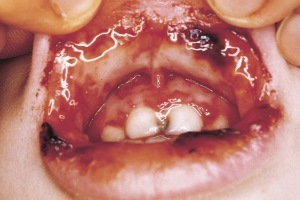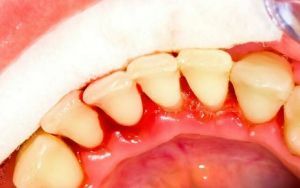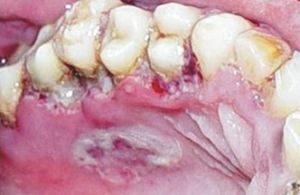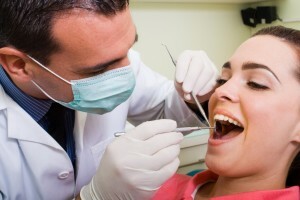I  Vincent's necrotic necrotizing stomatitis is a pathology that develops due to the infection of the oral cavity with spindle-shaped sticks.
Vincent's necrotic necrotizing stomatitis is a pathology that develops due to the infection of the oral cavity with spindle-shaped sticks.
The disease is accompanied by a sharp course of the inflammatory process, which affects all mucous membranes, as well as the formation of necrotic tissues. Most often, ulcerative stomatitis with necrotic foci is detected in children against a background of cutting through the teeth.
Contents
- Characteristics of the disease
- Clinical picture
- Diagnosis and treatment
- Features of nutrition
- Possible consequences
- Prevention measures
Characteristics of the disease
The pathological process develops against the background of infection of the oral cavity with spindle-shaped sticks. These microorganisms are present in the body of almost all people. The pathogenic microflora is activated by certain factors.
Activation of pathogenic microflora leads to the formation of foci of inflammation in the oral mucosa. Depending on the course of the disease, it acquires the following forms:
- acute;
- subacute;
- is chronic.
Initially, a severe form of pathology is observed in a person, characterized by an intense clinical picture. Vincent's stomatitis develops under the influence of the following factors:
- a neglected form of catarrhal gingivitis;

- weakened immune defense;
- mucosal dysfunction;
- inadequate oral hygiene;
- plaque and / or stone in large quantities;
- course of various dental diseases( extensive caries, periodontal disease and others);
- strong intoxication of the body;
- various diseases of internal organs such as leukemia, pathologies of the endocrine or digestive systems;
- pathology of viral etiology;
- strong neural surge;
- overstrain;
- trauma to the oral cavity.
The above factors lead to a decrease in local and general immunity, which creates favorable conditions for the development of pathogenic microflora in the oral cavity.
Clinical picture
The main symptom of Vincent's stomatitis is ulcers that form on the surface of the mucous membrane. They can have a single or multiple nature of distribution. The remaining symptoms of pathology depend on the severity of the disease.
At the initial stage( mild degree), stomatitis manifests itself in the form:
- of pain syndrome localized in the mouth;
- gum bleeding, aggravated by chewing food;
- active salivary glands.
When palpation of the gingival tissue, pain also occurs. On their surface, areas with hyperemia and edema are formed. In addition to pain, the patients suffer from itching and burning in the gums, as well as drying of the mucous membrane.
The average severity of ulcerative stomatitis is characterized by the following symptoms:
- on the gum edge, open wounds with a non-dead tissue are formed;

- intensive gum bleeding during the day;
- halitosis with an admixture of rot;
- in the gums are formed pockets with purulent contents, which is periodically released;
- increase and soreness of the lymph nodes;
- general weakness;
- decreased appetite;
- increased body temperature.
In the late stage( severe), the disease is accompanied by the appearance of:
- strong weakness;
- high temperature, reaching 40 degrees;
- attacks of nausea and vomiting;
- pain in the abdomen.
A characteristic sign of stomatitis is gray-white plaque, which is formed on the second or third day of the disease on the mucous membrane. In a number of cases, the inflammatory process penetrates deeply into the tissue, affecting the bone structure.
Ulcerative stomatitis in children is accompanied by the following symptoms:
- increased tearfulness;
- sleep disturbance.
The clinical picture in the chronic form of the disease is characterized by the absence of characteristic symptoms. The patient has bleeding gums and bad breath.
Diagnostics and treatment
 Diagnosis is based on the external examination of the oral cavity and the collection of information about the current status of the patient.
Diagnosis is based on the external examination of the oral cavity and the collection of information about the current status of the patient.
Additionally, histological examination of tissues is prescribed. In the surface layer of the gum, a variety of bacteria such as cocci, fusobacteria, spirochetes and others are found. In deep tissues, enlarged blood vessels and foci of inflammation are revealed.
Ulcerative necrotic stomatitis is one of the most dangerous diseases, the treatment of which takes place under the supervision of a dentist. Therapy of pathology is carried out in a complex.
For the suppression of the pain syndrome are prescribed:
- Anestezin( the most common drug);
- lidocaine hydrochloride, which is used in extreme cases.
After suppression of primary symptoms, an operation is performed to remove necrotic tissues. The procedure is carried out in several stages:
- Tampons impregnated with a solution of proteolytic enzymes are applied to the affected area. These substances soften the necrotic tissues.
- Then the treatment of the affected area with antiseptic and antimicrobial agents is carried out. In the presence of appropriate indications, hydrogen peroxide is used to remove necrotic tissues. Treatment of the oral cavity is performed under local anesthesia. It is important that during the procedure, medicinal substances penetrate into the interdental space. For this, a syringe with a blunt needle is used.
The first results of treatment become noticeable about 2-3 days of therapy. By this time, the gums stop bleeding and the necrotic tissue disappears. Epithelium begins to recover on 4-5 days.
Treatment of the disease is supplemented by the following procedures: 
- Taking antihistamines. They remove puffiness and suppress the inflammatory process.
- Reception of broad-spectrum antibiotics. These include Augmentin, Penicillin, Ampiox and others. Antibiotics are prescribed for extensive damage to the oral cavity and in neglected cases.
- Admission of vitamin complexes. They are necessary to strengthen the immune defense and accelerate the recovery process.
- Treatment of caries.
- Extraction of teeth with appropriate indications.
- Application of ointments and keratoplastic preparations to accelerate the healing of the expressed tissues.
Treatment of ulcerative stomatitis in children is carried out according to the same scheme that is used in the treatment of the disease in adults.
During the acute course of the pathology, bed rest is shown.
Features of nutrition
Successful recovery during and after the transferred ulcerative-necrotic stomatitis is impossible without observing a specialized diet. At the time of treatment from the daily diet should be deleted:
- sour and sharp foods( especially citrus);
- berries;
- products that cause an allergic reaction;
- marinated products;
- is sweet, bitter;
- dry products.
From the above it follows that the patient's diet for the time of recovery should not contain products that irritate the mucous membrane. The diet includes:
- dairy products;

- vegetable and fruit juices with a neutral taste;
- steamed and boiled meat, not containing salt;
- vegetable and meat broth;
- soft cheeses;
- a variety of cereals;
- boiled water in large quantities;
- tea.
This diet allows for a relatively short time to make up for the lack of trace elements and strengthen the immune system.
Possible consequences of
If left untreated, ulcerative necrotic stomatitis causes the following complications:
- pathology of the genital tract;
- inflammation of the middle ear;
- rhinitis;
- endocarditis;
- pleurisy;
- gastroenteritis.
Prolonged course of the disease promotes exposure of the roots and crowns of the tooth.
Prevention measures
Prevention of the disease consists in the following rules: 
- timely reorganization of the oral cavity;
- normalization of oral hygiene;
- strengthening of the immune system, in particular it is relevant during seasonal diseases;
- timely treatment of dental and other pathologies, elimination of microtraumas of the mucous membrane.
Vescent ulcer-necrotic stomatitis is a serious disease that causes significant damage to the oral cavity.
Pathology develops on the background of weakening of immune defense and requires timely treatment. Absence of therapy leads to exposure of the bone structure, loss of teeth and the emergence of a number of other diseases.
